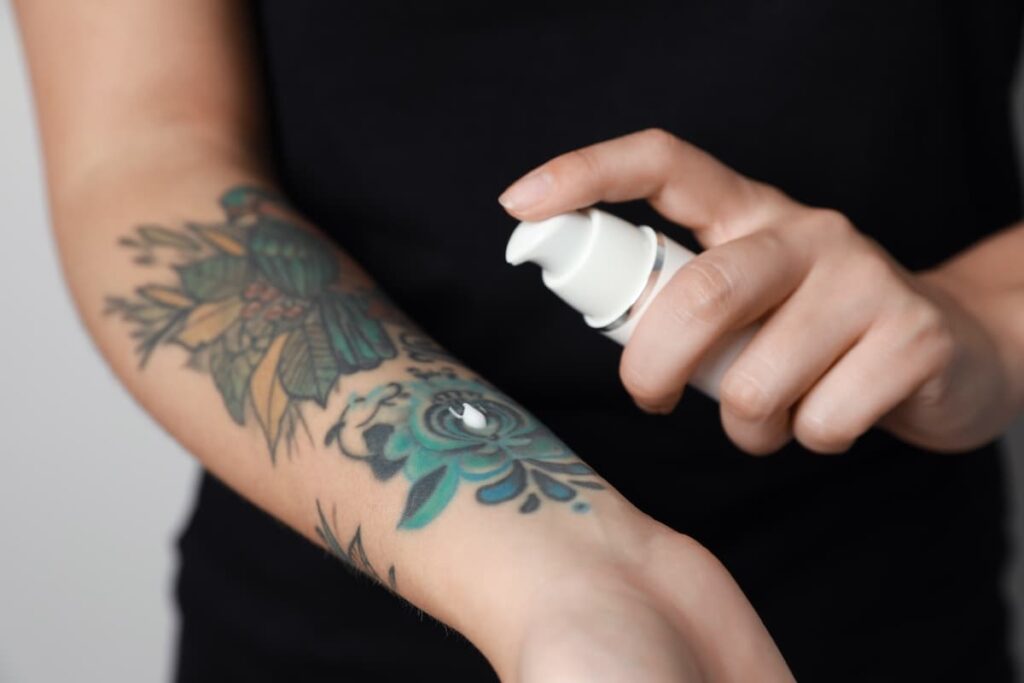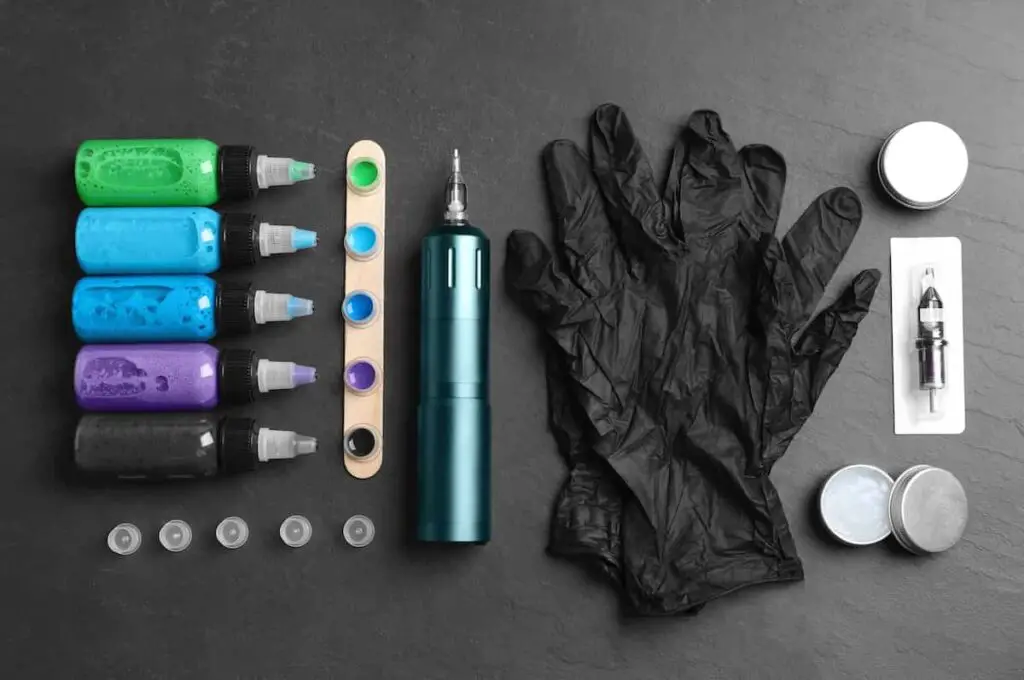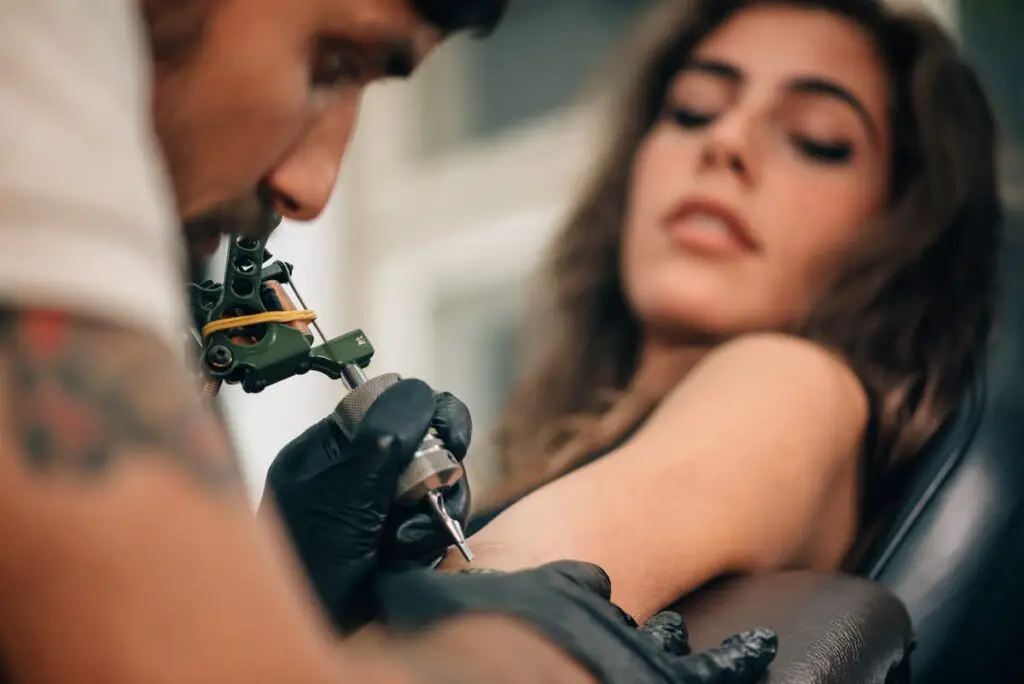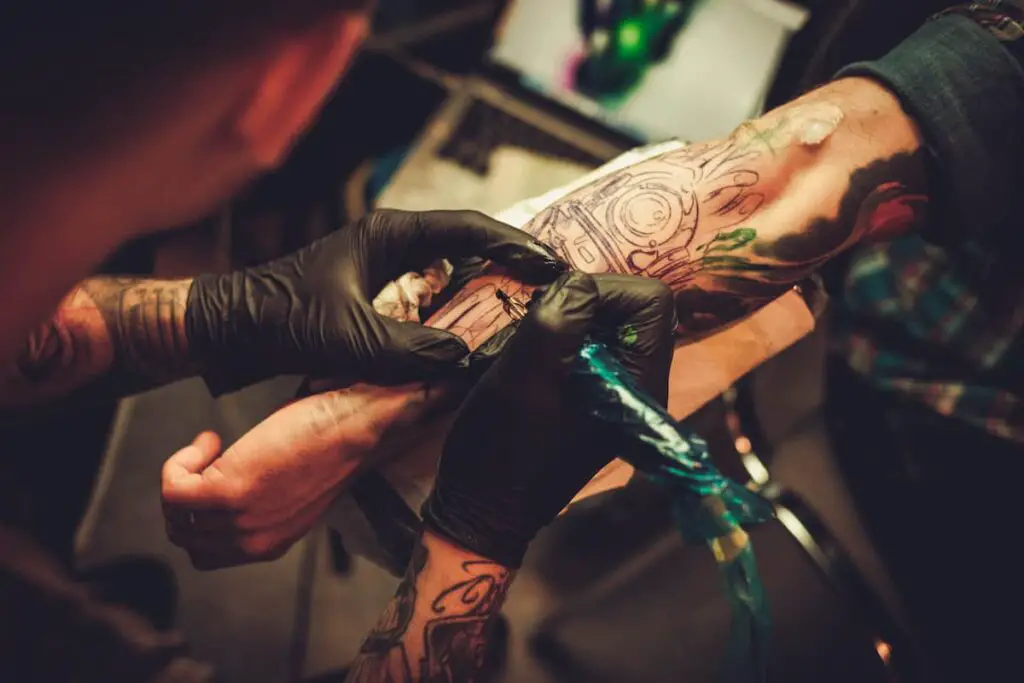Tattoos have been a popular form of self-expression for centuries, yet misconceptions and tattoo myths still exist today. From questions about the permanence and pain of tattoos to concerns about colors and health risks, it’s important to debunk these myths to understand the practice of tattooing better and help potential clients make informed decisions about their body art.
This article will explore 10 common tattoo myths and provide evidence that dispels these misconceptions. By debunking these myths, you’ll see there’s more to tattoos than meets the eye and that tattooing is a complex and nuanced craft.

Taking Perspective Into Account
As we dive into the world of tattoo myths and misconceptions, it’s crucial to remember that everyone’s experience with tattoos may differ. What one person may find painful, another may see as a minor inconvenience.
However, it is through knowledge and understanding that we can dispel the myths and misconceptions and appreciate the unique art form that is tattooing. Educating yourself on the realities of tattooing can help eliminate any unwarranted fears and ensure your tattoo experience is positive.
Myth 1: Tattoos Fade Quickly

One common misconception about tattoos is that they fade quickly and easily, losing their vibrancy in a short time. This myth likely stems from a lack of understanding about the tattooing process and the role of proper aftercare in maintaining a tattoo’s appearance.
In reality, the duration and intensity of a tattoo’s color largely depend on factors such as ink quality, skin type, sun exposure, and the individual’s aftercare routine. When a skilled tattoo artist uses high-quality ink, and the recipient follows good aftercare practices, a tattoo can maintain its brightness for many years.
It’s important to note that some fading over time is natural and inevitable as the ink gradually breaks down in the skin. However, this process can be significantly slowed down by taking certain precautions:
- Avoid excessive sun exposure, which can cause the ink to fade quickly. When outdoors, applying sunscreen to the tattooed area can help protect the tattoo from the sun’s UV rays.
- Keeping the tattoo clean and moisturized, especially during the initial healing process, can help maintain its vibrancy.
- Avoiding harsh chemicals or skin care products on the tattooed area can prevent unnecessary fading.
Individuals can enjoy vibrant, long-lasting body art by being mindful of these factors and taking good care of their tattoos.
Myth 2: Tattoos Are Unsafe

Some people may believe tattoos are unsafe, posing various health risks to individuals. However, this is not necessarily true. The safety of getting a tattoo largely relies on a tattoo studio’s sterilization practices and the ink quality used. Let’s explore these aspects in more detail.
Sterilization Practices
Professional tattoo studios know the importance of maintaining a clean and sterile environment, as improper sterilization can result in infections or health complications. Reputable studios adhere to strict hygiene practices, which include the use of:
- Autoclaves for sterilizing instruments
- Disposable gloves and barriers to prevent cross-contamination
- Single-use needles and tubes
- Clean, sanitary surfaces for clients
By choosing a reputable and professional tattoo studio, you can help ensure that you receive a tattoo in a safe and sterile environment.
Ink Quality
The quality of ink used in a tattoo is another factor contributing to the procedure’s overall safety. Some inks on the market contain potentially harmful metals, such as lead or mercury, that can cause health complications. However, many tattoo artists now opt for safer pigments in their inks that do not contain these dangerous metals.
High-quality tattoo inks are less likely to cause skin reactions and are generally considered safe. It’s essential to research the tattoo studio and artist before getting inked to gain insight into their ink choices and ensure they use high-quality, safe products for their tattoos.
Myth 3: You Can’t Donate Blood if You Have a Tattoo

One common misconception is that individuals with tattoos are ineligible to donate blood. In reality, having a tattoo does not disqualify a person from being a blood donor.
Certain criteria need to be met for a tattooed individual to donate blood. A significant factor is the age of the tattoo. As a general rule, potential blood donors should wait at least three months after getting a new tattoo before attempting to donate blood.
Another important consideration is the location where the tattoo was obtained. Donation centers are more likely to accept blood from individuals whose tattoos were administered by a licensed tattoo artist or parlor that adheres to strict sanitation guidelines.
Sometimes, temporary deferral from blood donation might be necessary if a person has received a tattoo in an unregulated facility. The risk of transmitting infections, such as hepatitis or other bloodborne pathogens, is the primary reason for this deferral period.
Myth 4: People with Tattoos Are Less Professional

Despite a widespread assumption that tattoos may hold individuals back in their professional lives, this stereotype has been proven largely unfounded. In reality, tattoos generally have minimal impact on an individual’s professionalism, work ethic, and competence in the workplace.
In recent years, society’s perception of tattoos has evolved dramatically, with an increasing number of professionals across various industries embracing body art as a form of self-expression. As a result, many companies have become more open-minded and have relaxed their strict dress code policies to accommodate employees with tattoos.
Of course, the impact of tattoos on one’s professional image may vary depending on the specific industry, company culture, and the size or location of the tattoo. In more conservative work environments, discreet placement of body ink may be recommended.
Here are a few facts to consider:
- Research has shown that tattoos do not affect an individual’s job performance or their ability to collaborate and communicate effectively with colleagues.
- Many successful professionals, including CEOs, lawyers, doctors, and teachers, proudly display their tattoos without experiencing negative repercussions in their careers.
- As tattoos become more mainstream, many companies are adapting their policies to reflect a more tolerant and inclusive approach to body modification and personal expression.
In conclusion, the myth that people with tattoos are less professional is largely outdated. It should not be considered as a determining factor when assessing an individual’s abilities and work performance.
Myth 5: Tattoo Removal Is Impossible

Many people believe tattoos are permanent, and it is impossible to remove them once inked. However, this is a myth, and there are various ways to remove tattoos, including laser and surgical removal.
Laser Removal
Laser tattoo removal is a popular and effective method for removing tattoos. Contrary to the myth, this technique can successfully remove or significantly fade a tattoo. The process involves using laser light pulses to break down the ink particles in the skin. The body’s immune system then flushes these particles out, resulting in a lighter tattoo or complete removal.
It is important to remember that the success of laser removal varies depending on factors such as the tattoo’s age, color, and ink density. In general, older and black ink tattoos are easier to remove compared to brightly colored ones.
Surgical Removal
Surgical removal of tattoos is another option, especially for smaller tattoos or where other removal methods may not be effective. This involves excising the tattooed skin and suturing the remaining skin together. While this method guarantees complete removal of the tattoo, it may leave a scar and is generally reserved for specific cases.
In conclusion, tattoo removal is not impossible, as debunked by the effectiveness of laser and surgical removal techniques. As with any medical procedure, certified professionals should do tattoo removal, and adequate research is essential when selecting a suitable method for each individual case. The outcomes may vary, but it is essential to maintain realistic expectations and follow proper aftercare instructions to achieve the best results.
For more information, check out our post on the Costs of Tattoo Removal.
Myth 6: All Tattoos Reflect Poor Decision-Making

Contrary to popular belief, not all tattoos result from impulsive decisions or a lack of foresight. Many people put a significant amount of thought and research into the tattoos they choose to get. It is important to recognize that people have different reasons for getting tattoos and that these reasons can contribute to the overall meaning and significance of the ink.
Some individuals choose to get tattoos as a form of self-expression or to commemorate important events, relationships, or values in their lives. These tattoos often hold deep personal meaning and are carefully planned out. Additionally, people from various cultures and backgrounds have used tattoos for expression, storytelling, and cultural identity for thousands of years.
The tattoo industry has also evolved, with growing numbers of skilled and reputable tattoo artists providing clients with expert advice, guidance, and designs. This professional support enables individuals to make informed decisions about their tattoos, ensuring that they are happy with the result.
While some tattoos may reflect poor decision-making, it is inaccurate and unfair to make such a generalization about all tattoos. It is essential to consider the unique circumstances and motivations behind each person’s choice to get inked rather than assuming that every tattoo results from a bad decision.
Myth 7: Tattooing Is Too Painful to Endure

Many people believe tattooing is an extremely painful process that may be too difficult to endure. However, this myth is not entirely true. The pain level experienced during a tattoo session varies from person to person and depends on factors such as tattoo placement, individual pain tolerance, and the tattoo artist’s technique.
While it is true that getting a tattoo involves some level of discomfort, many people find it tolerable and not as terrible as the myth suggests.
Pain Management Options
There are several options to help manage the pain associated with tattoos. Many tattoo artists recommend deep breathing or focusing on something other than the pain to help relax and cope with the sensation – music or movies are popular distractions.
Others suggest taking breaks, allowing the body to rest and recover during a long tattoo session.
In addition, there are products available that can help reduce pain and discomfort during the tattooing process. Topical anesthetic creams, gels, and sprays can be applied to the skin to numb the area and make the process more comfortable.
It is essential to consult with the tattoo artist before using these products to ensure compatibility and proper use.
By understanding the various pain management options available and debunking the myth of tattooing being too painful to endure, individuals can make informed decisions about getting a tattoo without unnecessary fear and anxiety.
Myth 8: All Tattoo Artists are the Same

One common misconception about tattooing is that all tattoo artists are the same. This myth couldn’t be further from the truth. In reality, tattoo artists vary greatly in their styles, specializations, and experience, and finding the right one for your specific tattoo needs can make all the difference in the outcome of your tattoo.
Styles and Specializations
Tattoo artists often have unique styles and specialize in specific tattoo techniques or themes. Some artists excel at traditional styles, while others focus on realism, blackwork, or watercolor-inspired designs. Some tattoo artists may be highly skilled in creating intricate geometric patterns, while others are masters of portrait tattoos.
When looking for a tattoo artist, it is essential to review their portfolio to determine if their style aligns with the design you have in mind. A tattoo artist specializing in your desired style is more likely to deliver the best results.
Furthermore, many artists have a particular focus on, for example, cultural or spiritual designs, such as Japanese or Polynesian tattoo art. If a particular culture influences your design, consulting an artist experienced in that area may help ensure both the artistic quality and cultural authenticity of your tattoo.
Artist Experience
Not all tattoo artists have the same level of experience. Some may be just starting their careers, while others have decades of experience. An artist’s experience level can significantly impact their mastery of various tattoo techniques, artistic vision, and overall craftsmanship.
It’s essential to consider an artist’s experience to ensure they can execute your design to the highest possible standard. Reading reviews or seeking recommendations from friends can provide valuable insight into an artist’s work and client satisfaction.
Ultimately, debunking the myth that all tattoo artists are the same is crucial in your search for the perfect tattoo. Each artist has something unique to offer, and finding the right fit for your design requires research and understanding their individual styles and areas of expertise.
Myth 9: Tattoos Prevent You from Getting a Job

One common misconception surrounding tattoos is that they will negatively impact a person’s ability to find a job or develop a successful career. While it is true that some workplaces have rules and regulations regarding visible tattoos, the modern professional world has evolved to become more accepting of body art and personal expression.
The perception of tattoos in a professional setting can depend on various factors, such as the industry, the location of the tattoo, and the company’s culture. Many companies, especially those within creative industries or with a younger workforce, might have more relaxed policies about tattoos.
Additionally, research has shown that tattoos do not always hinder job prospects. According to a study by the Harvard Business Review, tattooed individuals’ job prospects might not be as negatively influenced as initially believed. Only about 80% of HR managers and recruiters expressed negative feelings about visible tattoos, pointing out that some employers are more open to hiring individuals with tattoos.
That said, individuals considering getting a tattoo should consider the potential impact on their professional life. It is crucial to understand the norms and expectations within their chosen industry and any specific company policies. Opting for tattoos in more discreet, easily concealed places might be the best option when in doubt.
Myth 10: Tattoos Are Only for a Certain Type of People

One common misconception about tattoos is that they are only for a specific type of person or subculture. Television, movies, and societal expectations have long perpetuated this stereotype. However, it is essential to debunk this myth and recognize that tattoos are a form of self-expression and art.
Tattoos are found among various backgrounds, professions, and cultures. People from all walks of life choose to get inked for various reasons, such as to pay tribute to loved ones, to express their beliefs, or as a form of creative expression.
In recent years, tattoos have become more mainstream. Many professionals, including doctors, lawyers, and teachers, can have tattoos as a form of personal expression without affecting their careers.
While some tattoos can represent memberships or affiliations to certain groups or organizations, most tattoos do not signify any exclusive association. Resist the urge to form judgments about people based merely on their tattoos because those tattoos are individual choices and expressions of personal identity.
Which Myth Truth Surprised You?

Were you surprised to learn the truth about any of these myths? As you now know, the practice of getting tattoos has evolved in this country, and they’re more widespread today than you may have realized.
We hope this article has you thinking differently about tattoos, the people who choose to wear them, and what their tattoos mean to them. Maybe you can even see yourself getting one!
If you’re now entertaining the idea of getting your first ink, head over to our Tattoo Meanings series of blog posts. Read up on the symbolism and meaning of different tattoo images to see if any of them feel like they’d be right for you.


